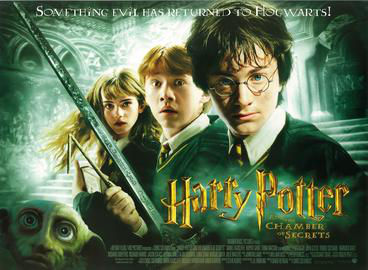The world’s most famous wizard and his friends are back in school, and the big screen, with the release of Harry Potter & the Chamber of Secrets—the second installment in this film franchise.
If the first Harry Potter film was rather light and heartwarming with just a little bit of evil and darkness to bring everything to balance, Harry Potter & the Chamber of Secrets takes the evil and darkness just a step higher with students now being targeted by a seemingly phantom assailant. Sure, there were still bits of comedy and light scenes with the help of the house-elf Dobby (voice provided by Toby Jones), the exceedingly obnoxious and flamboyant Gilderoy Lockhart (Kenneth Branagh), and, of course, the bubbly Molly Weasley (Julie Walters). However, it is quite obvious from the storyline of both the film and the novel from where the film was adapted from that Harry Potter and his friends are slowly growing up and setting the stage for more mature themes as could later be seen in the succeeding novels. 
It was also here in Harry Potter & the Chamber of Secrets that we are given a glimpse into the secret to Lord Voldermort’s immortality, which was explained and revealed in the later novels. So, while this may have been the second film, it can very much be regarded as the beginning of the much deeper, darker story behind the beloved novel series.
Striking as well in Harry Potter & the Chamber of Secrets is its artistic ability to address a distinct issue faced by many children in real-life: bullying. In one scene, Hermione is bullied by Draco Malfoy (Tom Felton) by being called a “mud-blood”, which is the foulest and lowest term to call a Muggle-born, or those that come from non-magical families. Despite being the most promising student in her class, the mere fact that her parents are non-magic folks makes her the target of bullying, particularly by “pure bloods” like the Malfoys. While it would have been nice to see some resolution offered in the film about the bullying incident other than Ron Weasley suffering from the curse meant for Malfoy backfiring on him because of his defective wand, adding this into the film made the characters more relatable to the viewers, fictitious as they may be. 
As with the first film, director Chris Columbus and screenplay writer Steve Kloves have tried to stay as faithful to the J. K. Rowling novel. The same holds true with production designer Stuart Craig who returned to design the additional elements and sets that were introduced in this installment. He even went so far as to find a Ford Anglia to create the magical car featured in the film as how it was described in the novel. Unfortunately, this time around, the wanting to stay true to the novel has caused many of the otherwise striking and important scenes to somehow fall rather short.
Nevertheless, it wasn’t a total loss. Harry Potter & the Chamber of Secrets proved to be a well executed film at par with the first. At the same time, it somehow is able to stand on its own, meaning that you really don’t need to watch the first film to get a full understanding of what transpires here. That is a very rare trait you’d find in sequels, and one more reason why this film definitely is worthy of praise.








